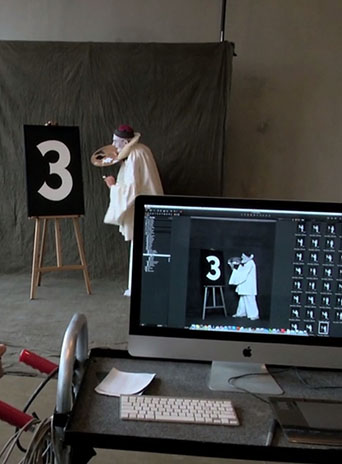From expanding options for working with images in Moodle to managing information flow for a fully online film course with 800 students, faculty members in the School of the Arts, Media, Performance & Design (AMPD) have creative approaches to adapting eLearning for the arts.


Instructors came together on Nov. 27 for a panel presentation to share their trailblazing efforts in this quickly evolving arena.
The celebration was organized by David Gelb, AMPD eLearning lead and professor in the Department of Design, and Michael Longford, professor in the Department of Digital Media and one of the AMPD project champions for Academic Innovation Fund activities.
“This presentation is a model for York University,” said William Gage, associate vice-president, Teaching and Learning, during the event.
Gage said he can “clearly see” that AMPD is a leader on campus, and recent feedback on AMPD projects presented at the Designs on eLearning Conference last September in London is evidence that the content being created in AMPD is world-class.
“We believe there’s a growing appetite for blended courses among our students, and augmenting those with some fully online offerings allows more flexibility in how students engage with course material,” said Longford. “We all have unique learning styles, and there are definite benefits to online teaching, from being able to revisit recorded lectures, to consistent expectations across multiple tutorials, to the instant feedback of an online quiz. Through multiple iterations in design in response to ongoing student feedback, our courses continue to improve.”

Department of Visual Art & Art History Professor Katherine Knight and Cinema & Media Arts Course Director Gillian Helfield both launched into their presentations by saying “I love Moodle”.
Collaborating with York’s Leaning Technology Services (LTS) and University Information Technology (UTI) divisions, Knight is working to find ways to better integrate images into her Moodle site for her first-year course, Critical Issues in Visual Art.
“Thanks to the incorporation of media galleries into York’s Moodle last September, every assignment now includes making an image in response to course material, and the images are uploaded into a gallery where they can be shared with other students for comment,” said Knight. “Allowing image creation and sharing inside Moodle has also made the course more engaging for all of us.”
Helfield’s first-year Cinema & Media Arts course for non-majors, Hollywood Old and New, was recently redesigned with support from the Ontario Shared Online Course Fund. This fully online course averages enrolments of 600 to 800 students. With 19 tutorials, and seven or eight teaching assistants involved, information management, consistency of experience and fostering a sense of community have become Helfield’s primary goals.
“We’ve created a teaching assistant manual with grading rubrics to support the TAs’ initial training,” said Helfield. “We’ve also established a good balance between essay assignments and quizzes to reduce the grading load and allow the students to get some of their marks immediately.”
The content is revised every year based on student feedback, she said, which allows her to find “that balance of simplifying the information flow without compromising the pedagogy”.
“I’ve really enjoyed the evolution,” Helfield said.
 Originally hesitant to move to online course delivery, Department of Music Professor Matt Vander Woude was astonished by the student response to critical issues in his Rock & Popular Music course for non-majors, offered online last year.
Originally hesitant to move to online course delivery, Department of Music Professor Matt Vander Woude was astonished by the student response to critical issues in his Rock & Popular Music course for non-majors, offered online last year.
“We’ve all taught reluctant participants in our classes,” said Vander Woude. “It was amazing to see how much the students became engaged in the Moodle forum – shyness was not an issue. I recognize that heated debate has a lot to do with the content and how you present it, but the high level of thoughtful discourse has me really excited about what an online forum can do.”
Gelb and Longford led the development of Interactive Art + Design Learning Modules, an interdisciplinary eLearning initiative accessible to faculty and students around the world. Created in collaboration with Brock and Ryerson universities, with support from York’s Academic Innovation Fund and the Ontario Shared Online Course Fund, the project features web-based modules that introduce key concepts in the theory and practice of new media at the intersection of art and design, science and the humanities.

Each module offers a range of recorded audio/visual mini-lectures, interviews with experts, case studies, and suggested learning activities with links to readings and other educational resources. Topics covered include transhumanism, new media history, principles of interaction design, fundamentals of physical computing and programming for hardware and software design, and interactive screens for urban environments. The modules are shared through Creative Commons license at www.iadlm.ca.
“Instructors can use the entire suite of videos and accompanying learning activities, or they can opt to integrate just one module into an online, blended or face-to-face course,” said Gelb. “We want teachers to sign up for the content and tell us how they use it. We’re really excited to get these ideas out there.”
Across all the presentations, a recurring success story is the support for multimedia content generation arising through the participation of work/study students. From shooting and editing audio and video, to helping with graphic design and uploading content to the web, AMPD Instructional Technology Coordinator Lillian Heinson and a team of four work/study students had a hugely successful summer creating highly professional content while providing the students with valuable skills development opportunities.
“Mobile technologies are transforming the ways in which we access and interact with information,” said Longford. “My laptop, phone and tablet are my gateway to news, entertainment, managing my finances and increasingly my primary point of contact with family and friends.
“It is time to be thinking how best to integrate such technology into our teaching too,” she said.


